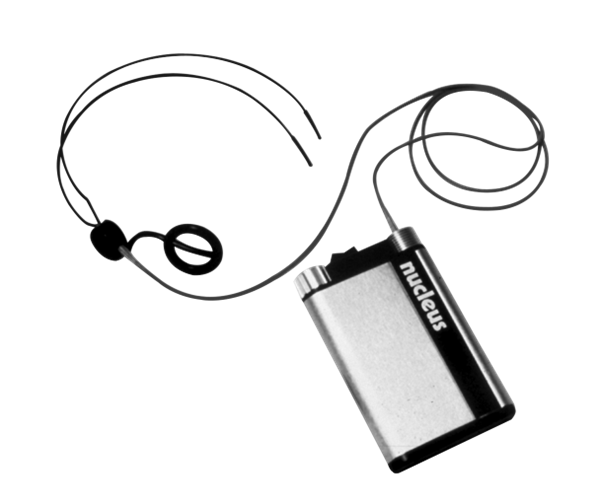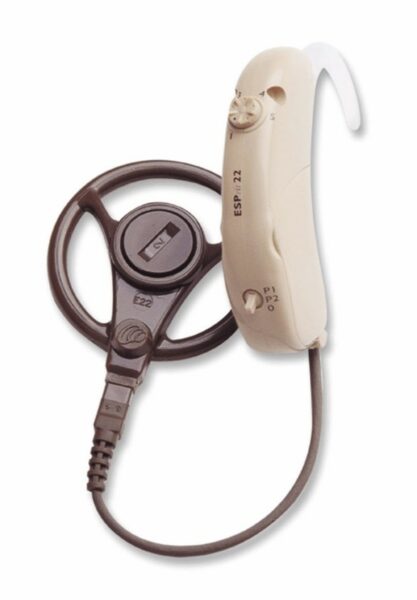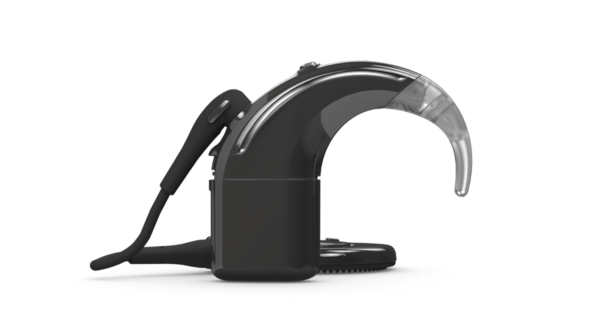Ever wonder about the Nucleus® System evolution over the past 40 years? We travelled back into the archives, and spoke to some of our earliest recipients, to see how the technology has changed and what that means for recipients around the world.
1977-1997: Introducing a new way of accessing sound to the world

Professor Graeme Clark had been working on developing a treatment for hearing loss for over a decade when he invented the first multi-channel cochlear implant back in 1977, with Rod Saunders becoming the first to hear with it in 1978.
Then in 1981, Cochlear was born when a company called the Nucleus group partnered with the Australian government to bring the first commercially available multi-channel cochlear implant to more people. Four years later, the Nucleus® 22 Implant and the Wearable Sound Processor (WSP) became the first multi-channel system to receive premarket approval from the FDA.
If you went back in time, you would be surprised at how big our first sound processor was: it was box-shaped, worn with a shoulder strap. A wire went from the box up to your ear.
“My first sound processor was body-worn and required a wire that went under my clothes to connect to the microphone and coil on my head. It was all new, and we didn’t have all the resources and help we have today,” says Pat, who received her Nucleus 22 Implant in 1988 at age 46.
More than 30 years later, Pat, who lives in the US, now loves going to see live symphony concerts and has upgraded her sound processor six times.
“It’s so much more comfortable. Being able to wear it on the ear without wires has been one of the biggest improvements since those early days. And the advances in programming options have been astounding.”
1997-2017: Innovating how you hear and live

The Nucleus Sound Processor started to look more familiar to the ones worn today. In 1998, we released of the first behind-the-ear sound processor, making it smaller and more user friendly as well as more comfortable and discreet.
In 2005, Cochlear released the first water-resistant sound processor – the Nucleus Freedom® Sound Processor – giving people with a cochlear implant the confidence to enjoy an active lifestyle with their sound processor. In 2012, Aqua+1 accessories were launched, enabling people to swim with the sound processor for the first time.
After the release of the Nucleus 5 Sound Processor (which was the smallest and most water-resistant sound processor when launched in 2009), the Nucleus 6 Sound Processor was released in 2013, introducing SmartSound iQ2with SCAN3 technology and wireless connectivity. True Wireless™ accessories, released the following year, offered more ways for recipients to access audio directly from their TV, phone or through a Mini Microphone, without needing bulky devices with wires.
The first Nucleus Kanso® Sound Processor was launched4 in 2015, offering an off-the-ear hearing solution designed to be more comfortable for people who wore glasses. It also meant recipients now had a choice in sound processors, along with the Nucleus 6 Sound Processor.
2017-2023: Smaller size and direct streaming are game changers
The launch5 of the Nucleus 7 Sound Processor in 2017 also heralded the first sound processor which allowed streaming directly from a compatible iPhone®, iPad® and iPod touch®. Android™ compatibility6789 followed a year later. This introduced a whole new way for recipients to stream videos, phone calls and access video conferencing.
Casey, from the US and one of the earliest child recipients, shares his thoughts on how the changes over the past few decades have helped him: “The technology has leapt ahead since 1987. For one, sound processors are a lot smaller! People don’t even notice them… I love streaming music and telephone calls. Wireless connectivity even blocks out any background noise, making phone calls even more accessible.”
In 2022, sound processors continued to get even smaller and lighter with the release of the Nucleus 8 Sound Processor,10 which is also the first to be ready to provide direct streaming using next-generation Bluetooth® LE Audio11. Once it’s available, you’ll be able to connect to what’s being broadcast at public venues such as airports, conference centers, sports clubs and gyms supporting Bluetooth Auracast™12 whether you’re listening to music, taking a phone call, or watching your favorite film, Bluetooth LE Audio delivers better sound quality than the previous generation to help you get the best possible audio experience.1314
To find out more about the latest Nucleus 8 Sound Processor and the latest features, visit our website.
- The Cochlear Nucleus 8 Sound Processor is dust and water resistant to level IP68 of the International Standard IEC60529. The Nucleus 8 Sound Processor with Aqua+ is dust and water resistant to level of IP68 of the International Standard IEC60529 when you use a Cochlear Power Extend Rechargeable Battery Module or Cochlear Compact Rechargeable Battery Module. The Nucleus 8 Sound Processor with Aqua+ can be continuously submerged under water to a depth of up to 3 metres for up to 2 hours. The Aqua+ accessory should be used when participating in prolonged water activities. Refer to the relevant user guide for more information.
- It is recommended that SNR-NR, WNR, and SCAN be made available to any recipient, ages 6 and older, who is able to 1) complete objective speech perception testing in quiet and noise in order to determine and document performance and 2) report a preference for different program settings.
- SNR-NR, WNR and SCAN are approved for use with any recipient ages 6 years and older who is able to 1) complete objective speech perception testing in quiet and in noise in order to determine and document performance 2) report a preference for different program settings.
- Launch dates relate to the US; other countries may differ.
- Launch dates relate to the US; other countries may differ.
- The Nucleus 8 Sound Processor is compatible with Apple and Android devices.
- Apple is the trademark of Apple Inc., registered in the U.S. and other countries.
- Android is a trademark of Google LLC.
- For compatibility information and devices visit www.cochlear.com/compatibility and www.resound.com/compatibility
- Cochlear Limited. D1631375 Nucleus 8 Sound Processor Product Definition. 2022, Oct.
- As Bluetooth LE Audio compatible devices become available, a firmware update will be required for you to use certain features.
- Auracast™ broadcast audio capability is subject to third party adoption of the Auracast protocol.
- Hunn N. Introducing Bluetooth® LE Audio [Internet]. [Cited 2022 Jan]. Available from: https://www.bluetooth.com/learn-about-bluetooth/recent-enhancements/le-audio/
- A Technical Overview of LC3 [Internet]. Bluetooth® Technology Website. [Cited 2022 Feb 28]. Available from: https://www.bluetooth.com/blog/a-technical-overview-of-lc3

